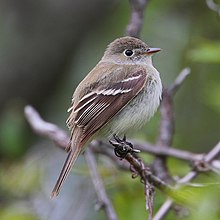Empidonax minimus
| Least flycatcher | |
|---|---|
 |
|
| Scientific classification | |
| Kingdom: | Animalia |
| Phylum: | Chordata |
| Class: | Aves |
| Order: | Passeriformes |
| Family: | Tyrannidae |
| Genus: | Empidonax |
| Species: | E. minimus |
| Binomial name | |
|
Empidonax minimus (Baird, 1843) |
|
The least flycatcher (Empidonax minimus), (also called chebec, or chebecker, after the sound it makes), is a small insect-eating bird. It is the smallest Empidonax flycatcher in eastern North America.
The closest relative to the Least Flycatcher was thought to be the Hammond’s Flycatcher based on the similarity of their song and appearance. However, analysis recently revealed that the Least Flycatcher diverges significantly from its congeners and does not possess any sister taxa.
The least flycatcher is hard to distinguish from the other birds of its genus. The bird is one of the smallest of the Empidonax genus, measuring 12 to 14 cm in height with a wingspan of 19 to 22 cm and weighing approximately 10.3 g. Its plumage is dull olive-gray on its back and whitish on its belly, notably brighter than the other Empidonax birds. The Least Flycatcher’s wings are lined with two white bars, and white rings contour its eyes. Its beak is short and the lower mandible is yellowish. The juveniles look similar to the adults except that their wing bars are slightly darker, with tawny/olive hues. Because other flycatchers also have those field marks, the best way to identify the Least Flycatcher is by its call and habitat.
The Least Flycatcher inhabits the Eastern Rockies of Canada, and the Central-North and Northeastern United-States. During winter, they migrate to central America and establish themselves from Mexico to Panama.
The Least Flycatcher lives in aspen clusters, orchards, shade trees and open woods. They breed in deciduous or mixed forests and occasionally in coniferous groves . They tend to prefer breeding sites near clearing or edges but can also nest in dry woods. They spend the winter in Central America where they nest in forest edges and second growth.
The least flycatcher also made its way in the open country. They often live in villages or city parks, nesting in shade trees and orchards, or along rural roads and forest edges.
The vocalization of the Least Flycatcher is often characterized as being dry and sounding like a piercing «che-bec» pushed with strength, the second syllable being louder than the first. During the hottest days of the summer, they often call incessantly.
...
Wikipedia

